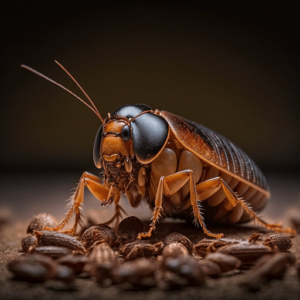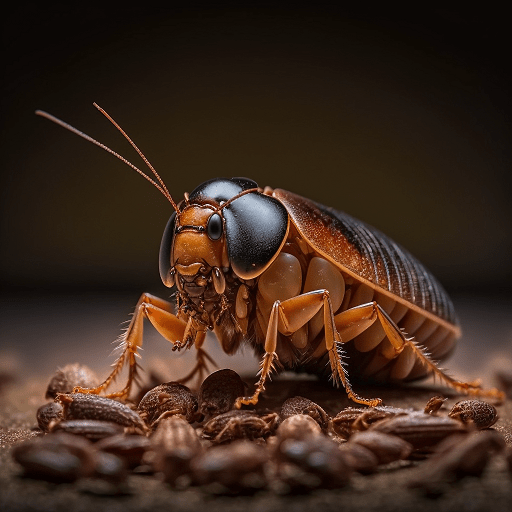Mormon Crickets
Table of Contents Mormon crickets, despite their name, are not true crickets, but a type of large insect that belongs

In case you have discovered German cockroaches in your home, you’re probably eager to get rid of them. Don’t worry – we’re here to help! In this step-by-step guide, we’ll walk you through the process of getting rid of these pesky insects in your home. From identifying these unwanted visitors to implementing effective strategies, you will find all the necessary information in this article. Say goodbye to those nasty pests as we equip you with the knowledge and tools to become a German cockroach killer. So, let’s roll up our sleeves and reclaim your home from these unwelcome intruders.
The German cockroach size is small: they are around ½ to ⅝ inches (12-15 mm) long only. It means that in the American vs. German cockroach comparison, the latter will not win. Their scientific name is Blattera germanica. Their coloration is light brown to tan, and they have two dark parallel stripes on the back and head.
These insects live in warm and humid environments, so you can encounter them indoors in residential and commercial buildings. They have a pretty rapid reproductive rate. Females have eggs cases called oothecae that contain 30-40 eggs. Like most cockroach species, these pests are nocturnal and omnivorous. They feed on a variety of organic substances, including human food leftovers, crumbs, grease, and even paper and glue.
Cockroaches are considered pests because they contaminate food and surfaces with droppings, shed skin, and saliva. That can spread allergens, bacteria, and pathogens which often trigger asthma symptoms and allergic reactions. That is why they need effective control which includes sanitation practices, proper storage of food and water sources, sealing entry points, and targeted pesticide application.

You can recognize the German cockroach infestation by the presence of adult insects that have slender elongated bodies with flattened shapes, which allow them to crawl into narrow spaces to hide. Among the distinctive features, let’s mention the following:
These distinctive features may vary depending on individual specimens, environmental factors, and age.
The cycle consists of three stages – eggs, nymphs, and adults. In the first stage, females produce egg cases called oothecae that contain 30-40 eggs. The incubation period of German cockroach eggs lasts 18-30 days depending on the conditions.
When eggs hatch, nymphs appear. They look like adults but are smaller in size and do not have wings. They start changing their exoskeleton in several stages (5-7), and each of them lasts about 20-40 days.
After the last nymph stage, they become adults with fully developed wings. Then, they live for about 100-200 days if their living conditions are favorable. Females can produce eggs throughout their adult life, and it highly contributes to rapid population growth.
If you want to know what the signs and indicators of the infestation are, they are the following:
Note that if you have occasionally seen one or two adult insects, it is not necessarily a sign of a full-blown German cockroach infestation. Though, if you have noticed other signs mentioned above, you need to address the problem immediately.
The continuous provision of shelter, moisture, and access to food sources is vitally important for the German cockroach life cycle. The insects can be found in the following places:
That is why if you suspect these insects’ appearance in your home, thoroughly inspect these areas and start preventive or eliminating measures as quickly as possible if you detect cockroaches.
There is a range of factors that contributes to cockroach infestations of houses and offices. Let’s consider some key ones:
Therefore, regular inspections, effective sanitation practices, home sealing and maintenance, and professional pest control in the case of invasions can help manage the problem.
It’s not a secret that German cockroach invasions can pose health risks to humans due to their potential to spread pathogens. The main problems are commonly associated with the following:
These health risks can be rather minor for most people, while those who suffer from allergies, respiratory conditions, and the compromised immune system, may be influenced.
The fact is that German cockroach bite is uncommon. These insects are scavengers that feed on organic matter, like food crumbs, other insects, and decaying materials. They do not even possess mouthparts for biting or piercing.
However, they may sometimes nibble on human skin if they consider it their food or are afraid of too close contact. It happens when the cockroach population is very dense and food sources are limited. Such nibbles are harmless. Though, people with poor skin conditions can experience allergies and skin irritations. It is essential to consult a healthcare professional for an accurate diagnosis and proper treatment.

In any case, experiencing a German cockroach infestation is never pleasant, so you would like to know how to prevent and control it.
The effective prevention measures include the following:
When you apply all these prevention measures consistently, you will reduce the risks of infestations and maintain a pest-free environment.
You can try some DIY methods if the infestation has happened but it is not too severe. The most effective of them are the following:
These methods, however, will not work for significant or persistent infestations, so you may need a professional German cockroach killer to improve the situation.
Types of cockroach killers and treatments can vary. The most effective options are the following:
You will need to follow all product instructions carefully and take necessary precautions while using them at home. An integrated pest management (IPM) approach, focused on sanitation, prevention, and targeted treatment, is a great solution.
All these pest control products available on the market have their pros and cons. Let’s consider some of them.
Therefore, the most important thing here is to pick out the most effective methods and used them in combination with other means due to the specific conditions of every household environment.
You need to know which insecticides, baits, and traps to use in your conditions. Let’s overview the most effective of them.
The most widely used and efficient insecticides are the Advion cockroach gel bait, Alpine cockroach gel bait, and Temprid FX. They contain powerful ingredients and can be spread throughout the colony for delayed-action killing. We can also recommend Maxforce FC Magnum and Combat Max Roach Killing baits that contain slow-acting poison that can be carried back to the nest and act for effective elimination of the entire colony.
As for traps, consider Catchmaster Roach Traps and Black Flag Roach Motel. They have a baited sticky surface that can attract, trap, and hold adult cockroaches. Read the instructions for every product carefully and follow their safety precautions.
Very often, professional assistance is the only way to deal with severe German cockroach invasions. Pest control experts have a lot of experience, expertise, tools, and methods to effectively exterminate and control these insects. They can inspect and assess the extent of the infestation, identify hiding places, and pick out the most appropriate treatment methods.
Then, a professional will make up a customized plan according to the findings. It will include the most appropriate techniques applicable to your environment. The technicians will apply these techniques and treatments immediately to the areas of cockroach activity.
After the cockroaches are exterminated, pest controllers will schedule follow-up visits to monitor the situation and re-apply the treatment if needed. They often use an integrated pest management approach (IPM) for long-term management and prevention. They recommend specific sanitation practices, sealing procedures, and reducing conducive conditions.
The safety of the family is a priority for professionals, so they follow strict guidelines and handle chemicals responsibly to minimize risks to people, pets, and environments. They know a lot about cockroach habits, behaviors, and methods to control them.
If you choose a reputable pest control company, insured, and licensed which employs well-trained workers, you will be satisfied and get rid of these pesky insects for a long. You may read reviews, seek recommendations, and get quotes from multiple companies before making the choice.
Professional German cockroach killer help has a lot of advantages. Here are some of them:
In fact, involving professionals in the solution of your cockroach-related problems will save you effort, time, and potential expenses related to continuous and severe infestations.
There are certain key points related to the German cockroach infestation and its elimination. They include correct identification, detecting the signs of cockroach presence, their nesting and hiding places, and the factors that contribute to these pests’ appearance in your household. You should also be aware of health risks, prevention measures, and integrated pest management (IPM). If the infestation is not severe, you may apply DIY control methods. If your house is already badly infested, you may need professional examination, application of pest control services, and efficient follow-up and maintenance techniques to prevent re-infestation.
Immediate action is crucial for effective cockroach control because German cockroaches reproduce rapidly, bring health risks, and infest new areas. That is why faster elimination is essential to minimize property damage. Your quick reaction will prevent the insects spread to other areas and ensure your peace of mind.
You need to take into account that these creatures are pretty resilient and adaptable, so the sooner you start getting rid of them, the better it will be for your environment. Your awareness, early intervention, prevention measures, and proper control will have a strong community impact, protect people’s health and well-being, save costs, and reduce the infestation impact on the environment.
All individuals should get enough knowledge and information to prevent and control cockroach infestations in their environment for making it healthier, safer, and more comfortable for everyone.
Though German cockroaches have wings, they are poor fliers. They can glide short distances but prefer running and climbing or jumping, if needed, to flying. They run quickly to find shelter in cracks and crevices.
German cockroaches are small insects, measuring around ½ to ⅝ inches (12-15 mm), of light brown to tan color, with a darker hue of their head. Their bodies are oval with flattened profiles, with fully developed wings they hardly ever use. The insects have long and thin antennae that are longer than their bodies for strong sensory perception. The most distinctive feature is two parallel stripes on their pronotum.
These pests get into houses by hitchhiking, with infested goods, through openings and gaps, via plumbing and drainage, arriving from nearby infestations, or hiding in infested packages and deliveries. You have to practice proper sanitation and inspect all the items brought into your home.
Their lifespan depends on various environmental conditions, availability of food and moisture, the presence of predators, and the effectiveness of control measures. The average lifespan in favorable conditions is 100-200 days (3 to 6 months) or even longer. Their life cycle is divided into three stages – eggs, nymphs, and adult insects.
These are two different cockroach species with notable differences. Brown-banded cockroaches are smaller – about ½ inch (12-14 mm) long, and their color is light brown to dark brown. Males have longer wings than females. German cockroaches are bigger – ½ to ⅝ inch (12-15 mm) long. They are light brown to tan, with two dark parallel stripes on their back and pronotum.
While brown-banded cockroaches are found in various parts of the world, including tropical and subtropical climates, German cockroaches are found globally in residential and commercial areas.
Brown-banded cockroaches prefer drier environments and hide in warm places. German cockroaches like more humid environments. The first species can infest multiple rooms very quickly, and they spread on upper floors, in electrical conduits, heating, and plumbing systems. The second species are common in kitchens and bathrooms next to the sources of food and water. You need to know their peculiarities and differences for more effective pest control.
German cockroach infestations are quite usual in homes and offices. They infest kitchens, bathrooms, and food storage places. They reproduce rapidly and pose certain risks to the home’s safety, health, and well-being. You need to know their peculiarities to get rid of these pests effectively. Swift action is essential, and prevention is a better way to control these insects than making efforts to eliminate and control them. Pest control professionals can help you eliminate cockroaches and prevent their second appearance on your property If you notice a cockroach in your home, you should apply a comprehensive approach to get rid of them for good.

Table of Contents Mormon crickets, despite their name, are not true crickets, but a type of large insect that belongs
Wolf spiders are generally not dangerous to humans: While wolf spiders can bite if threatened, their venom is typically not harmful to humans.
You can get advice and tips on how to kill cockroaches in your household and get rid of this pesky infestation for good. You will learn about these insects, their habits, ways of feeding, and habitats